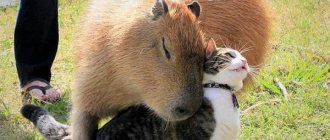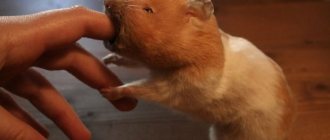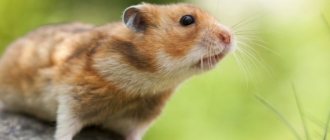What does the biggest hamster in the world look like?
Some sources mention the capybara, a giant rodent that has an external resemblance to a hamster. This animal lives in Central and South America. Its body grows up to 135 cm in length, and the weight of an adult exceeds 50 kg. The height at the withers is 45-50 cm. However, the capybara is not a hamster.
This animal belongs to the Capybara family. The largest rodent in the world has membranes on its paws, thanks to which it swims well.
The capybara feeds on coastal and aquatic vegetation, so it spends a lot of time in the water. Often the animal falls asleep in a pond with its head sticking out to the surface. This is a friendly animal that is easy to tame.
Some Americans keep a large rodent at home and are very happy with their choice. A striking example of this is the huge capybara Kaplin Rose, a capybara raised at home by Texas resident Melanie Tipaldos.
An American woman dedicated an online blog to her large pet, thanks to which she became popular. And Kaplin Rose's fans call her the fattest hamster in the world.
Common hamster
This species is the largest in the Khomyakov family. The body of an adult rodent reaches 27-34 cm in length. This is a truly gigantic hamster the size of an adult dachshund.
Exterior Features:
- A large hamster has a tail 6-8 cm long. Its base is quite wide and the tip is thin. It is covered with short, coarse hair.
- The muzzle is of medium length, with well-formed cheeks.
- The ears are short, thin, erect.
- Like other members of the family, the large common hamster has fairly capacious cheek pouches.
- Wide paws are equipped with long claws.
The large common hamster has thick and soft fur. The color of the upper body is reddish-brown. The abdominal area is black. There are 2 light spots on the sides, separated by a small island of black fur. There are also light milky spots on both sides of the head and behind the ears. In some subspecies they are also present in the area of the shoulder blades.
In nature, there are large common hamsters with pure black fur and individuals with a charcoal color and white spots on the limbs and neck.
Large common hamsters have 16 teeth, 12 of which are molars. Each jaw has 2 incisors. They grow throughout life. In the wild, a rodent constantly grinds them down when it eats rough food - branches of fruit bushes, dry grass and grain.
Hamster Radde
Another giant hamster is called Radde. It got its name from the name of the Russian naturalist. This rodent grows up to 28 cm in length. Moreover, the size of its tail does not exceed 1.5 cm.
The coat color on the upper part of the body is gray-brown, and the abdominal area is black. The fur around the anus is light brown. The fur on the cheeks and cheek area is lightened. There are black stripes between the ears and on both sides of the muzzle.
The most depressed hamsters
Each animal has its own characteristics in character. Without knowing them, it is difficult for the owner to understand what his pet wants and what his mood is. The hamster is no exception. Just like people, they can get depressed. It often occurs in pets in winter.
Hamsters feel anxious and restless. American scientists decided to use this property of rodents in order to understand the cause of depression in people and find ways to eliminate it. The study involved 53 female and 48 male dwarf hamsters under the supervision of a professor at Ohio Medical University.
The animals were limited in their access to daylight to simulate winter days. Scientists also conducted special tests for anxiety. The researchers placed the rodents in a large cardboard box and observed how long the hamsters stood near the walls for 1 hour. This is exactly how restless hamsters behave.
In addition, the animals were given a sweet drink for several days. If a rodent did not drink it, it was considered “depressed.” As a result of such an experiment, it was found that hamsters are susceptible to seasonal depression.
The most depressed hamster is considered to be a rodent named Chmurka. The facial expressions and behavior of this animal speaks for itself.
Habitat
The common hamster lives mainly in the steppe and forest-steppe zones of Eurasia. Its distribution area is quite wide. Animals of this species are found in the northwestern part of China, in the east and south of Siberia, in Kazakhstan and the northern part of Mongolia.
The large Radde hamster prefers to settle on already developed lands in the steppes, which are rich in perennial grasses. Representatives of this species are found in the Caucasus, Stavropol region, Ciscaucasia, and also in Georgia.
Reference. The number of common hamsters has decreased significantly over the past 20 years, so programs have been developed in different European countries to protect these animals.
Deception or truth
Among all this diversity, the capybara stands out, which many classify as hamsters. It is mistakenly considered the largest representative of this species. But it belongs to the capybara genus. The animal only vaguely resembles a hamster, which causes errors. Capybaras are quite trainable. They are often kept at home by residents of South America. A very large hamster is an animal from the category of myths.
Capybara with a cat
Habits and behavior
Large hamsters living in nature are nocturnal. During the day they climb into holes and sleep. The rodent's home is a complex underground system of passages. It can have from one to five exits and several compartments for storing food and nesting.
When dusk comes, rodents go in search of food. They run several kilometers during the night. They feed on seeds and leaves of plants, vegetables and tubers. Sometimes their diet includes larvae and insects, as well as small invertebrates.
The large hamster carries a huge amount of food into its burrow in its cheek pouches. Each of them holds up to 100 g of food. For the winter, he can prepare more than 20 kg of provisions.
Large hamsters prefer to live alone, so they do not even allow their relatives into their territory. Rodents pair up only to reproduce.
In the wild, even large hamsters have many enemies. These are large wild animals, birds and snakes. Since rodents cause damage to agriculture, people can also be considered their enemies.
In the natural environment, the life expectancy of a rodent is short - about 3 years. In captivity it can live twice as long.
Brief description of breeds
Golden homa
It is also often called Syriac. Currently, this breed holds the palm in popularity. Rodents are quite large (half the size of a mouse), but not so large that they can be entrusted to a small child.
The color of the fur matches the name of the breed: medium-length fur is usually reddish, golden or tan. There are black, white, spotted and even apricot colors.
Fiery beauties prefer privacy to the noisy company of relatives, but at the same time they are always happy to communicate with family members, quickly get used to their hands and love affection.
Angora breed
It is not difficult to guess that this breed of hamster belongs to the long-haired category. His middle name is real. Even in photos the animals look great, but in real life they act like a king.
This species is descended from Syrian hamsters and gets its name from its lush coat, similar to Angora cats. These rodents have nothing to do with angora.
Unlike their golden ancestors, they are distinguished by a wide variety of colors: white, cream, silver, tricolor. Surprisingly, men have much longer hair than women.
Dzungarian breed
Dwarves among their fellow tribesmen. The coat is painted in a smoky gray color with a clearly defined dark stripe along the back and a characteristic diamond on the forehead. The ears are black, the paws are white. Average length 10 cm.
Unlike previous species, hamsters are independent; they do not particularly like human attention. They are distinguished by their eccentric character: they often fight in groups. Therefore, it is best to keep them alone or popular in a group of their age from birth. They are mainly nocturnal.
Campbell
Another one of these little ones. They are often confused with Dzungarians, although the differences are visible at first glance:
- firstly, the color of this breed of hamster is yellow-brown;
- secondly, the stripe on the back and the diamond on the forehead are not clearly drawn.
They also prefer solitude, so this species is more interested in observing their lives and habits than in communicating.
Sungur breed
Distinctive features are large bulging eyes, a bulbous nose, an arched croup and hairy paws, for which the hamster received the nickname “fur paws.”
But the breed is unique not only for its unusual structure, but also for its ability to change color depending on the season: the less hot and sunny it is, the lighter the coat becomes.
Roborovsky breed
Quite a rare breed, although many would like to have these incredibly active, lively and cheerful children. At one time, it practically disappeared from the face of the earth, but American scientists managed to restore and even increase the population.
The true representatives of the species are truly tiny creatures and are considered the smallest, not counting Taylor's dwarf, among all species of domestic hamsters. It is best to keep rodents in pairs or even small family groups.
The coloring is typical for deserts and semi-deserts: white belly, pink back, black ears with a white border.
Taylor's dwarf
This is actually a wild breed, but adapts well to life in captivity. They enjoy communicating with people and feel quite comfortable in a cage - they prefer a well-fed and calm life.
The size is small - only 5cm.
By the way, such sizes require special painstaking selection of the cage, but it is better to keep babies in glass or plastic containers, which will be difficult for them to chew.
Ordinary
At most, it is not even Gulliver among the entire family of hamsters: the average height is 25 cm. Despite the ordinary and ordinary name, the hamster is distinguished by its bright and contrasting color:
- red back;
- black belly;
- on the face and sides there are two light dots separated by a black stripe.
Pets come across a calmer coat - black or black and white.
Yin Yang
It is difficult to say that black and white animals are a separate breed of hamsters.
For example, albinos can be found among the Youngs, Syrians and Campbells. In nature, white rodents are easy prey for predators, so there are few of them in their natural habitat. The snow-white color is highly valued among breeders.
Black hamsters are as rare as white ones. Charcoal hamsters are usually born in litters of the Syrian or Dzungarian race.
Siberian animal
Another breed of fur paws. Externally, Siberians are very similar to Djungarians and also change their dark color to lighter in winter. Rodents are very small and active, so keep them in a glass terrarium. As a last resort, a cage will do, but with a very small intersection gap.
Care and maintenance of hamsters at home
Large wild hamsters are not kept as pets. It is almost impossible to tame them - they are shy and aggressive. Such animals can cause serious injuries to the owner with their sharp and long teeth.
The largest hamster that can be kept in an apartment is the Syrian. True, in size it is much inferior to its wild relatives.
It weighs just over 100 g, and the rodent's body length is 13 cm.
The Syrian hamster is easy to tame. The main thing is to pay attention to him every day - approach the cage, treat him with a treat, and when he gets used to the smell of the owner’s hands, you can let him climb into your palm. Very little time will pass and the hamster will cease to be afraid of humans.
Cage and equipment
Your pet hamster will need a cage made of steel mesh with a retractable plastic tray. Its minimum size is 40x50 cm.
It’s better to immediately buy a more spacious cage, because the equipment will be placed inside:
- house for sleeping;
- running wheel;
- feeder;
- drinking bowl
You can increase the area of the rodent's home due to the second tier. In this case, you will also need stairs or tunnels that will connect the floors to each other.
Hamsters are quite sensitive to drafts, so the rodent’s home should not be placed on a windowsill. It is better to place it at the back of the room. The animal is kept at a temperature not lower than +16 and not higher than +28 degrees. Hypothermia can cause a hamster to get sick, and overheating can cause death.
Hygiene
Your hamster's cage needs to be cleaned regularly. Filler - corn or wood - is poured onto the bottom. It retains moisture well and hides unpleasant odors. The litter is changed every 5-7 days. The tray and containers for food and water are washed with the same frequency.
Bathing a rodent is not recommended. If the fur is dirty, it is better to try to remove the dirt with a damp sponge or cut it with scissors.
Record holders for size
The largest hamster in the world is the capybara Caplin Rose. The owner of the giant pet is Melanie Typaldos. The weight of the animal is 64 kg, and the body length is 1.4 meters. Melanie named her pet after the huge rodent from the fairy tale “The Princess Bride.” Typaldos claims that the animal is very friendly and plays with children and even dogs.
A hamster's favorite pastime is to swim in the river, and then eat ice cream and fall asleep. Melanie even writes a blog about her pet, which is popular.
Appearance of the largest animal
You can see in the photo what the largest hamster in the world looks like. There are some features in their body structure:
- Pets' ears are short and covered with hard fur.
- The tail at the base is thick.
- The fingers have fairly developed claws.
- Wide feet.
Rodents have a uniform color, which can vary from red to brown. Black individuals are rare. There are approximately 10 subspecies of such animals.
Tama the Cat: Train Station Master
This happened in the early 2000s, when the unprofitable Kishi station in the Japanese city of Kinokawa was almost closed due to unprofitability. Residents, of course, protested, but it is unlikely that their efforts would ultimately be crowned with success. The situation was saved by a local cat named Tama, who loved to bask in the sun near the train station. The station manager noticed how enthusiastically passengers reacted to this couch potato and gave him the official position of caretaker. The cat was given a uniform cap, a badge and a monthly salary in the form of free food.
The duties of the newly minted minister included advertising functions. He greeted passengers, allowed himself to be petted, and was always somewhere on the platform. It must be said that this policy very quickly led to commercial success. Tourists began to come to Kishi station just to look at the railway cat and take pictures with him. From that moment on, there was no further talk about closing the station.
But the unusual cat's career did not end there. In 2008, Tama became a supervisor and was charged with monitoring the performance of professional duties by staff. That same year, the cat was knighted. Another year later, according to the project of the famous designer Eiji Mituku, the railway included in the schedule a train dedicated to the legendary animal. The carriages were painted with views of Tama, the locomotive was decorated with his muzzle, and meowing signaled the opening (closing) of the doors. But this did not become the crown of the cat’s career.
A year later, Tamu was appointed third party of the railway company, entrusted with the post of executive director. By his old age, it was already difficult for him to work every day, and the management allowed the elderly cat to come to work 3 days a week.
Tama died at the ripe old age of 14. But even after this, the career did not end. Posthumously, the cat was elevated to the rank of Eternal Station Master, thus perpetuating his memory. After all, over the years of work, this four-legged employee has brought considerable income to his company. The tourist flow through the station increased to 300 thousand people annually, and the financial indicator amounted to more than 1.1 billion Japanese yen.
The company's management did not want to accept the loss of such a profitable and already promoted advertising brand. Tama was replaced by Nitama (the second Tama). True, later with the third cat there was an overlay. He was found at Okayama Station and offered a position in Kishi. But the owner did not agree to the move. Next came Yontama (the fourth Tama), who had already had to undergo a special training course before taking her place on the platform of the railway station.
And the flow of tourists wanting to take a photo with the legendary heirs of the first Tama still does not dry out.
I like2I don't like
Fact No. 10. A married pair of hamsters can give birth to up to 24 babies at a time!
Hamsters are born in spring and summer, and in most cases their number does not exceed 7-8 individuals. But there are cases when one couple had 24 cubs at once! Can you imagine this crowd?
Video about the ideal playground for a hamster:
OK it's all over Now. There is only one thing left to add - each hamster is unique and has its own character and habits. The owners probably noticed special oddities about their pet, which only added to its funniness. What can you tell us about your pet?
People learned to tame animals thousands of years ago, they observed their behavior, instincts, habits and used this information to better understand our smaller brothers. Now we can use such information, for example, interesting facts about hamsters, to find a common language with our pet. Hamsters are now quite popular as pets, but are our views similar to them?
Perhaps one of the most interesting topics to discuss about hamsters is their vision of the world. The very existence of such a question raises the assumption that our views differ. This is actually true.
Hamsters are highly myopic
Now let's figure it out one by one, how do hamsters see? Since these animals show their main activity at night due to natural predators, they do not need well-developed daytime vision. Hamsters have highly developed myopia; they see relatively clearly only nearby objects, while the rest of the world is blurred and only outlines can be discerned.
This way they can navigate well and not collide with anything (all attention is directed to a small area of the terrain)
As for light perception, it is developed rather poorly, the shades of red day are indistinguishable, but orange and green are quite. This feature appeared due to the need to get food for themselves at night, so if you want to impress a hamster, add yellow and green tones to their life.
Here's a small example of how hamsters see:
A hamster's mustache also helps them understand the world.
Many animals mark their territory, hamsters are one of them, for this they need special scent glands that emit a specific smell. Tubules extend from the glands, through which this smell then spreads. Usually the animals mark the bedding and bars of the cage, but if the owners are not careful, the animal will also mark the furniture and carpets where it often roams.
They will not explore the same territory all the time; they will rather remember it and notice individual changes. By the way, if you dim the lights while walking your hamster, he will be much more comfortable.
Reproduction
In their natural habitat, dwarfs breed from April to September. At home, under good conditions, they can give birth throughout the year.
Hamsters are able to reproduce after reaching three months of age. The female's gestation period is three weeks; at the end of pregnancy, the female gives birth to 5 to 8 cubs. When the time comes for the female to give birth, it is better to place the cage in a quiet place with dim lighting. It is advisable that in the room where the cage is located there are no loud sounds, no TV or music playing.
Hamsters are born hairless and blind. They develop fur at the end of the first week of life, and after another week they open their eyes. You should not touch newborn hamsters: a foreign smell can cause the female to reject the offspring and even destroy the cubs.
Newborn hamsters feed on mother's milk for approximately the same amount of time. During lactation, you need to add a little boiled egg white, cheese or boiled chicken to the female's diet.
Young females or animals under stress may abandon their young and even begin to eat them. If the cubs have not yet reached the age of ten days, it is impossible to save them: it will not be possible to feed a newborn hamster.
The young should be housed in separate cages a month after birth. Young hamsters should not be near their mother for more than five weeks. This is due to the fact that after a month the hamster is already able to fertilize a female, including her own mother. And such frequent births can harm the health of the animal.
Peppermint treat
Ingredients:
- 1 medium overripe banana.
- 2 chicken eggs.
- 3 tbsp. spoons of honey.
- 3 tbsp. tablespoons of liquid coconut oil (can be replaced with sunflower oil in the same amount).
- 1/2 teaspoon mint flavoring.
- 1/2 teaspoon baking powder.
- A quarter cup of carob (roasted carob powder). A small amount of cocoa can be substituted, but this is not recommended for animals. Therefore, try to find an original product.
- Oat flour.
Cooking procedure.
1. Mash the banana in a bowl.
2. Beat eggs into the resulting mass, add honey, baking powder, cinnamon and coconut (sunflower) oil.
3. Add oatmeal to the mixture to form a firm but slightly moist dough.
4. Divide the resulting volume into 2 equal parts.
5. Pour 1/4 cup of carob powder into one half, and add the same amount of flour to the second half. A hard lump should form that does not stick to your hands.
6. Roll out 2 rectangles, 9-10 mm thick.
7. Place the layers of dough on top of each other and roll along the long side. Wrap the resulting sausage in plastic wrap and put it in the refrigerator overnight.
8. Preheat the oven to 180 degrees.
9. Cover a baking sheet with parchment paper.
10. Remove the film and cut into 3-3.5 cm rounds.
11. Place on a baking sheet. During cooking, portions of dough will not increase in volume, so you can place them close to each other.
12. Bake for 10-15 minutes.
If you want to please your pet with a crunchier treat, cut the rolls into thin slices (about 1 cm), and after cooking, additionally dry them in a warm oven or even in a non-stick frying pan.
The finished product is stored for a long time in a dry place. So, by baking peppermint rolls once, you can treat your four-legged pupil with them for a long time.
Bon appetit to your dog!
I like it I don't like it
Summarize
Features of keeping a shaggy hamster of the Syrian breed:
- It is not picky about living conditions and is practically silent, with the exception of night time. To prevent the hamster from disturbing your sleep, you can take it out into the hallway or another room at night.
- Consumes little feed.
- Calmly relates to manifestations of affection from the owner.
- Angora hamsters reproduce without problems in captivity.
Possible content difficulties:
- An Angora hamster will bite if your hands smell of something tasty or if you frighten it.
- The baby is prone to obesity, so take care of exercise equipment, the minimum set is a running wheel.
- To ensure the highest quality care, place the following attributes in the cage: a drinking bowl, a sand bath, a chalk stone.
- When the temperature drops to +10 degrees, the Angora hamster can hibernate.
- Since this is a rodent, it can chew anything that gets in its way, so allow it to walk only under your supervision or in a fenced area.
- An uncleaned cage can cause an unpleasant odor.
Now you know that the Angora hamster is a type of Syrian breed. In order for your furry to live a long and happy life, do not overfeed him, choose a balanced diet, clean his cage, and do not house him with roommates.
If you are scared by stories that hamsters are aggressive and can bite your finger, know that this does not apply to cutie Angoras. The hamster will quickly get used to you and become a true friend.
Not all hamsters are small. There are also quite large individuals, and even the largest hamster in the world - the capybara. Among the common species there are rodents whose weight reaches 700 grams and whose body length is up to 30-35 cm. The fattest hamster is not found among such varieties as dzhungariki, Syrians or red ones. A large individual requires special care. It is necessary to take care of the optimal size of the cage, as well as purchase a high-quality wheel.
Guard! What to do if you are overweight?
No need to panic, take action. If you have asked a veterinarian for help, he will help you create the right diet and daily routine. Or take care of it yourself.
So: good mood, diet and exercise. First of all, solve the issue with training. In nature, rodents travel several kilometers a day, so they need exercise. Buy a quality wheel and a special ball for walking around the room
Pay attention to playing with your hamster, but do not forget to keep a close eye so as not to lose him
Now it's time to reconsider your diet. How often do you feed your hamster fatty nuts and seeds? It is not necessary to exclude them, just cross out junk food from the daily menu and use it as a rare treat.
a href=”https://letsreboot.files.wordpress.com” >letsreboot.files.wordpress.com
Add as many vegetables and fruits as possible. Carrots, cabbage, celery and apples are great. Never offer your pet oranges - sour citrus fruits harm digestion and cause stomach diseases.
Finally, make the fat guy work hard for food! There is no need to carefully put it in the feeder every day. Move it to another part of the cage so that the hamster has to run around in search of a hearty dinner. Don't worry, he will benefit from burning some calories.











